The daunting thing about the car market right now is how expensive non-luxury-brand vehicles have become. On average, they have increased in cost by an astounding $20,000 over the past roughly for years.
But there are, interestingly enough, some luxury-brand vehicles that aren’t particularly expensive – relative to what it costs to buy a comparably-equipped non-luxury-brand vehicle.
One of these is Lincoln’s Corsair.
What It Is
The Corsair is a compact-sized luxury crossover that shares a platform with the Ford Escape.
Being a Lincoln, it comes standard with equipment that’s optional with the Escape as well as a powerful plug-in hybrid version that isn’t offered with the Escape.
Prices start at $39,385 for the Premium trim, which comes standard with the 2.0 liter, turbocharged engine that’s the Escape’s optional (and extra cost) engine as well as LED headlights, 18 inch wheels, synthetic leather seats and a 13.2 inch LCD touchscreen. Some of these features are available (also optionally) in the Escape but if you order them, you’ll be edging close to the price of this Lincoln.
And you’ll still be driving home a Ford.
Not that there’s anything wrong with driving home a Ford. The point is you could be driving a Lincoln, instead.
This Lincoln also offers a 266 horsepower plug-in hybrid drivetrain already mentioned up above – that is not available with the Escape. It can be driven about 27 miles if you start out with a fully charged battery. After which – like a conventional hybrid – the gas engine automatically starts to keep you going. This version of the Corsair also comes standard with an adaptive suspension system that’s not available with the Escape and you can luxury-brand amenities such as a 14 speaker Revel premium sound system, massaging front seats, heated rear seats and Blue Cruise self-driving tech.
It stickers for $54,265.
What’s New For 2025
The Corsair carries over into the new model year essentially the same as last year.
Extremely affordable – relative to other compact-sized luxury-brand crossovers such as the Mercedes-Benz GLC 300 (which lists for $49,250 to start) and the BMW X3 (which lists for $49,500 to start).
Available plug-in drivetrain offers the option to plug in without the having to plug it in.
Kinship to the Escape is not obvious.
What’s Not So Good
Plug-in’s all-electric range is less than that of other plug-in hybrids in the class, such as the Benz GLC 300 (which can go about 40 miles on a fully charged battery).
Good-looking (and sloping) roofline cuts down on second row headroom.
Diamond pattern grill is made of expensive-to-replace plastic.
The Corsair comes standard with a 2.0 liter, turbocharged four cylinder engine that advertises 250 horsepower. It is the same engine that’s optionally available in the higher trims of the Escape – which ends up costing nearly Lincoln money when you buy it so equipped. If you don’t, all you’ll get is a 1.5 liter three cylinder engine – and 180 horsepower.
The Lincoln’s standard 2.0 liter engine is paired with an eight speed automatic and front wheel drive. An all-wheel-drive system is available as a stand-alone option.
The Grand Touring trim comes standard with the plug-in hybrid drivetrain mentioned earlier. It consists of a 2.5 liter four cylinder engine teamed up with an electric motor and battery pack that can be recharged by plugging it in – or not.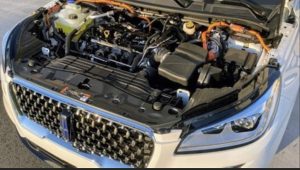
The latter is italicized to make clear the difference between a regular hybrid – which must be driven to charge up its battery – and an electric car, which must be plugged in to charge its battery.
A plug-in drivetrain allows the vehicle to be driven without burning any gas for short hops – about 27 miles in the case of this Lincoln – without having to stop for a charge. When you use up the vehicle’s all-electric-driving range, the gas engine automatically kicks in to both keep you moving and top-off the battery pack as you drive, similar to the way a regular hybrid works. When you have time, you can plug the Corsair in. But you don’t have to – if you haven’t got the time. This flexibility is the chief draw of the plug-in hybrid drivetrain.
The Corsair’s plug-in hybrid drivetrain advertises 266 horsepower – 16 more than the standard 2.0 liter engine that’s standard in the non-hybrid versions of this small crossover.
It’s also more powerful than the Escape’s available plug-in hybrid drivetrain, which advertises 210 horsepower and comes only with front-wheel-drive (AWD is standard with the plug-in hybrid Corsair). The Ford plug-in does go farther – about 37 miles – on a fully charged battery. And it offers significantly higher gas mileage – 42 city, 37 highway – vs. 34 city, 32 highway for the Lincoln.
On the other hand, the Lincoln can pull up to a 3,000 lb. trailer while the Escape – with its standard three cylinder engine – is only rated to pull a maximum of 2,000 lbs. With its available plug-in hybrid drivetrain, this goes down to just 1,500 lbs.
The plug-in hybrid set-up can be seen as a way to get around what is styled “electrification.” By which is mean the federal government pushing electric vehicles on people by pushing those that are not off the market by imposing regulation only vehicles with plugs can comply with.
The problem is most people haven’t got time to spend on all this plugging-in. So they don’t buy electric vehicles. But the vehicle manufacturers are under pressure to manufacture them, to comply with the regs.
Selling them is another thing.
A plug-in hybrid has a plug, of course. And that helps it comply with the regs – because it is capable of operating as a “zero emissions” electric car. But it is also capable of just being ready to drive – without having to plug it in (and wait, while it recharges). That makes it easier to sell.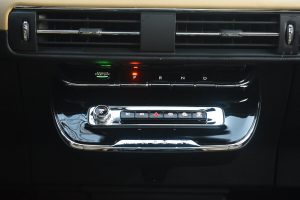
Driving the Corsair plug-in hybrid is like driving an electric car without the hassle. If you forgot to plug in last night, it will still be ready to go in the morning. It is not necessary to plan your life around plugging it in and you don’t have to be vigilant about how much charge you have remaining – because you can just keep driving.
This makes the electric-drive part non-stressful. And if your daily drive is say 20 miles or so there and back, you could save a lot on gas – assuming you are diligent about plugging it in when you get home. Either way, the drive will be smooth – and very quiet. This is appropriate when driving a Lincoln. The plug-in’s adaptive suspension delivers a soft, luxurious ride – something that is often lacking in luxury-branded vehicles that paradoxically also want to be “sporty.”
This is kind of like wanting to lose weight while also eating at McDonald’s.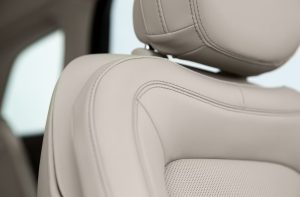
Part of the reason for the Corsair plug-in’s feeling luxurious to drive is also due to its weight – 4,493 lbs. That is immensely heavy for a compact-sized vehicle and it accounts for this Lincoln’s modest (for a plug-in hybrid with a small four cylinder engine) fuel economy.But the payoff is a vehicle that feels much larger than it is – because it is as heavy as a much larger vehicle. That sense of being planted is pleasant – and there’s no downside to it other than the gas mileage penalty for the extra weight this rig must haul around and some body roll in the curves if you insist on driving it fast in the curves, in which case why aren’t you looking at something “sporty” rather than luxurious?
The long and short of it is that it’s pleasant to spend time in this Lincoln, which also has some additional comfort-enhancing features such as seat cushions that can be individually extended, to allow for fine-tuning adjustment.
This Lincoln looks larger than it is – yet it is almost exactly the same overall size as the Ford Escape it shares a platform with. The Ford is 180.1 inches long vs. 181.4 inches long for the Lincoln. But unless you were to park the two side-by-side, you’d probably guess the Lincoln was larger – and not by a little.
This visual effect is achieved by giving the Lincoln what appears to be a longer (and wider) hood and sweeping back the roofline, which ends up being noticeably lower than the Escape’s by the time it reaches the rear of the vehicle. And it isn’t just visual effect. The Lincoln does sit lower – 63.8 inches off the ground at the highest point vs. 65.9 inches for the Escape.
The price you pay for the sleeker, larger-looking look is less headroom for both front and rear seat occupants: 38.4 inches (in both row) vs. 40 inches up front in the Escape and 39.3 inches in back. But it’s not a big difference and the more important point may be that the headroom in both of the Corsair’s rows is the same. It is more commonly the case in swooped-roof vehicles that there is dramatically less headoom in the second row – but that’s not the case here.
It also feels bigger inside – perhaps because the Lincoln touts 3-plus inches more legroom (43.2 inches) than does the Ford (40 inches). Also those seats – which are very plush and have that fine-tune adjustment of the lower seat cushion that is not available in the Ford and not common even in other luxury-brand rivals.
Like other luxury-brand vehicles in the class, this Lincoln comes standard with a digital/flat-screen main instrument cluster and secondary screen to control the stereo and AC, etc. But there are tactile controls – i.e., controls you can use by feel – such as the rotary knob on the lower portion of the center stack that you can use to turn up (or down) the volume of whatever you’re listening to. There is also a secondary thumb control on the steering wheel. These kinds of controls help you control things without risking loss of control – of the vehicle – because you weren’t looking at the road.
Being a Lincoln, the Corsair comes loaded.
There are only a few amenity upgrades as you go from the standard Premium trim up to the Grand Touring trim. The main differences are the drivetrains, with the exception of the Grand Touring’s standard adaptive suspension system. Other amenities – such as real (rather than synthetic) leather, larger (19 inch) wheels, adaptive headlights and the upgrade audio rig can be added to other trims as you like.
There is one other way that most plug-in hybrids differ from vehicles that have to be plugged in. It is that most plug-in hybrids – including this Lincoln – can only be plugged in at home. The Corsair plug-in cannot be “fast” charged at a public “fast” charger – in air fingers quote marks to make a point about “fast” only being so relative to how long it takes to recharge at home, as opposed to how little time it takes to fuel-up a gas-engined vehicle.
It takes about three hours to charge up the plug-in Corsair’s battery at home using a 240V outlet, which you may have to have installed in your garage or at least close enough for the cord to reach. Otherwise, it will take longer using a standard 120V household outlet.
But – again – the key point here is that you do not have to plug this hybrid in.
Ever.
The Bottom Line
If you’d like a luxury-brand small crossover that’s not much more expensive than a loaded small crossover without the luxury-brand (or the amenities) that’s also a lot less expensive than other small, luxury-brand crossovers – you might want to check this little Lincoln out.
. . .
If you like what you’ve found here please consider supporting EPautos.
We depend on you to keep the wheels turning!
Our donate button is here.
If you prefer not to use PayPal, our mailing address is:
EPautos
721 Hummingbird Lane SE
Copper Hill, VA 24079
PS: Get an EPautos magnet or sticker or coaster in return for a $20 or more one-time donation or a $10 or more monthly recurring donation. (Please be sure to tell us you want a magnet or sticker or coaster – and also, provide an address, so we know where to mail the thing!)
If you like items like the Baaaaaa! baseball cap pictured below, you can find that and more at the EPautos store!



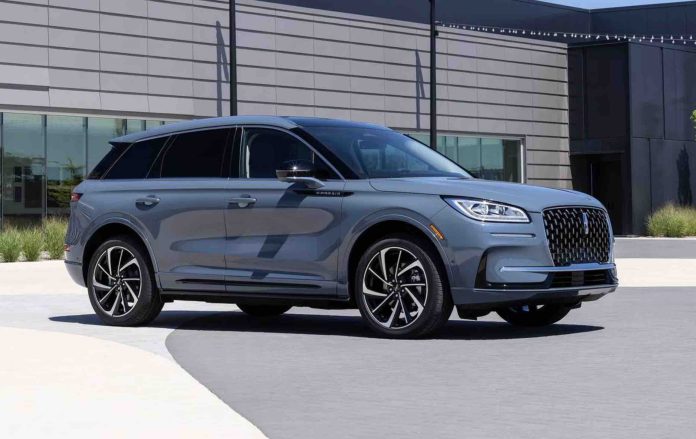

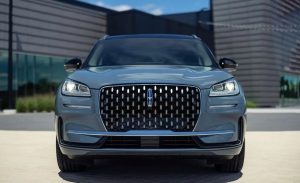












‘comes standard with the 2.0 liter, turbocharged engine’ … ‘its weight, 4,493 lbs … is immensely heavy for a compact-sized vehicle’ — eric
In Oldspeak terms, that’s a 122 cubic inch engine — ‘the size of two matchboxes,’ as my sixth grade teacher used to joke about the tiny 144 cubic inch inline six in his Ford Falcon. In a 4,500 lb land whale.
Here is the next-gen version of the Lincoln’s little powerplant:
https://m.media-amazon.com/images/I/61iFxAQS2-L._AC_UL800_QL65_.jpg
I will need to replace my MKZ at some point and I considered the Corsair until I found out they are imported from China, for me that is a non starter. About the grill, the grills on vehicles now are HUGE and I am wondering what ever happened to the five mph bumpers, I dont think these grills and front ends can withstand that kind of bump anymore.
Hi John,
The bumpers are still in place – hidden behind these plastic “fascias,” as they are styled. So they do provide impact protection. But zero cosmetic damage protection.
Related topic: PG&E shuts down power because of high wind
Wind power is great! Uh oh, It’s windy! Better be proactive and shut down the distribution lines just in case there’s an untrimmed tree that could touch off a fire.
Better hope your EV has enough charge to last through windy season.
Eric: “Diamond pattern grill is made of expensive-to-replace plastic.”
It’s hard to believe how much a plastic grill costs when you consider that 50 years ago they were chrome plated pot metal that lasted the life of the car and didn’t crack if you knocked the winter ice off of it with a snow brush.
Intriguing review of an interesting approach with mild hybrid by Lincoln.
Another knock out of the park by Eric, but the overwhelming concern again….
The 55 GRAND needed to buy a small luxury ride…yikes!!!
But, with Orange Man Bad getting SELECTED again, enough people may jump in for this splurge vehicle!!
Thanks, Saxons!
I worked on that one yesterday to take my mind off the election. This morning, things are looking better!